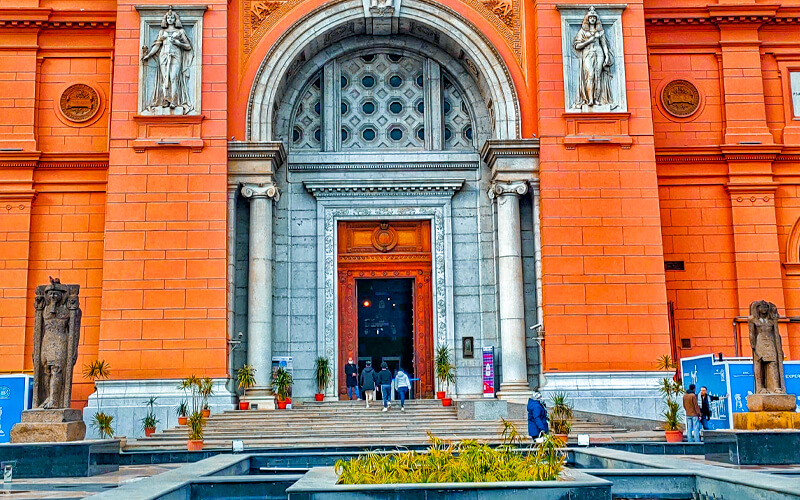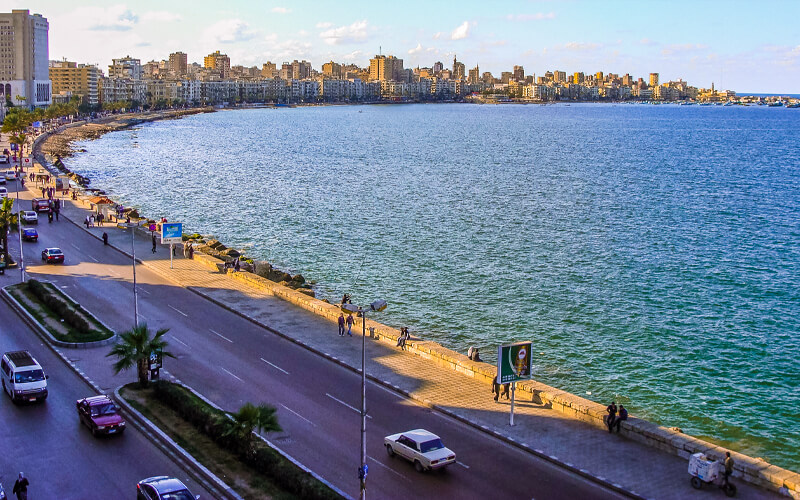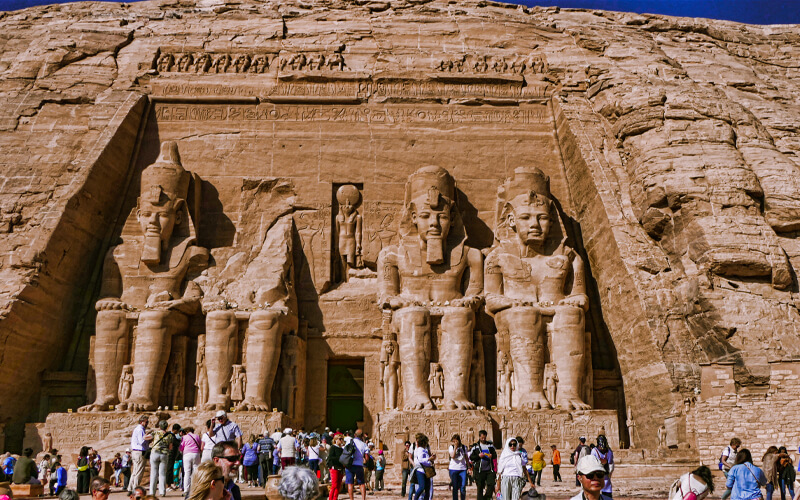Egyptian Museum
The Egyptian Museum in Cairo, Egypt.
The Egyptian Museum, which is centrally positioned on the outskirts of Tahrir Square in Cairo, is difficult to miss on any tour of the city. It was constructed specifically to store artifacts from ancient Egypt when it opened its doors in 1902. The museum has the world’s largest collection of archeological history from the ancient Egyptian period.
Egyptians refer to Downtown Tahrir Square, which is located in the center of Cairo’s downtown, as Wust el-Balad, which translates as “the heart of the city.” The rationale for this designation is that the Downtown region is the section of the city that is brimming with life and activity. Cairo, Egypt’s capital city, is commonly referred to as “the city that never sleeps,” and the same can be said about Downtown. It is not only the geographic center of Cairo, but it is also the hub for all of life’s activities and facilities, as well as a meeting place for people from all over the world. Midan Talaat Harb and Midan Tahrir are two of the most well-known restaurants downtown.
In the Museum, you may see the contents and items on display.
There are about 120,000 objects on display in the Egyptian Museum in Cairo, which includes the contents of Tutankhamen’s tomb as well as the majority of the mummies that have been found since the 19th century. In the museum, you may see artifacts dating back to the beginning of the Old Kingdom of Ancient Egypt (about 2700 BC) and up to the Greco-Roman era. Each level of the building has a different layout. You may go through Egypt’s history from the Old Kingdom up to the Greco-Roman era by taking a left at the entrance and looping around the museum on the ground level. This serves as an excellent backdrop for the majority of Egypt’s ancient history.
The museum’s upper level is structured thematically, with a considerable section of the space devoted to the display of the contents of Tutankhamun’s tomb, which includes his famed funerary mask, among other items. In addition, there is a chamber devoted to the exquisite jewelry unearthed in the Royal Tombs of Tanis, which is located on the second floor. The Royal Mummy Room, which is another centerpiece of the museum, is accessible only via the purchase of a supplementary ticket. There are mummies of some of Egypt’s most renowned pharaohs on display here, including Ramesses II and Seti I, as well as Egypt’s only queen, Hatshepsut, among others.
There is so much to see and do at the museum that it might be overwhelming. A significant portion of its contents has not been relabeled or restructured since they were initially put in their cases more than a century ago, which causes it to be difficult to navigate. Thus, some parts give minimal context for the artifacts, and labels are shown in a range of languages, including French and English as well as Greek and German. Arabic labels are also included. Visitors often express dissatisfaction with the displays’ navigational difficulties, which is an excellent incentive to have a guide with you.
A collection of ancient antiquities from all over the globe may be found at the Egyptian Museum, also known as the Museum of Ancient Egyptian Civilization, which is located in Cairo, Egypt. The valuable riches of King Tutankhamun and several other ancient Egyptian greatest pharaohs, as well as the possessions, mummies, jewelry, and meal bowls of Ancient Egyptians, were all kept inside the walls of the large and old pinkish edifice situated in Downtown Maidan Al-Tahrir.
More than 100,000 antique artifacts have been discovered.
A vast and massive collection of artifacts, mummies, coffins, stones, old goods, and even food kinds were kept at the Egyptian Museum in Cairo and were formerly buried with the kings before death to be utilized in the afterlife. Ancient Egyptians used to bury their deceased with all of their goods because they thought that they would be able to utilize their clothing and food in the Afterlife, which was part of their religious beliefs and practices.
Interestingly, not only were their worldly possessions interred beside them but so were their “servants” as well, which is a fascinating detail. As archeologists unearth new finds throughout time, the Museum’s collection continues to increase at a fast pace. Examples include Tutankhamun’s massive tomb and the remarkable discoveries that were uncovered within it, as well as the burial possessions of Tanis, which were both discovered after the museum opened and are now on display at the museum. Currently, the museum has more than 100,000 antique artifacts, which is a significant number for such a little space. Some items have been relocated to the new Grand Egyptian Museum, but the majority of them are still on display in the main museum on Tahrir Square in Cairo. Even when the Grand Museum opens its doors, the museum in Tahrir Square will continue to be the primary repository for ancient Egyptian artifacts. Ancient antiquities were fully prohibited from being exported out of Egypt in 1835 by Mohammed Ali, the country’s monarch at the time, to conserve the country’s cultural legacy.
The Museum’s security is quite good.
Security concerns were mostly addressed by simply closing the museum’s doors at night, which was the standard practice until 1996. However, robbers were able to gain access to the building despite the security measures in place. As a consequence, the museum’s authorities installed several security alarms and detectors around the building, as well as upgraded the lighting system across the whole facility. During the Egyptian revolution of 2011, thugs assaulted and looted the museum, stealing various antiquities from its collection. The individuals who were there at the moment intervened immediately and bravely to prevent more theft from occurring. For security reasons, they created a human chain around the building in Tahrir Square, and they were successful in protecting the museum.
The Exhibits of the Old Kingdom include:
This time in ancient Egyptian history, known as the “Pyramid Builders Period,” was a crucial one that left us with a wealth of interesting artifacts and things, which is why it is given such a large part in the museum. The Pyramids of Giza, the Step Pyramid of Saqqara, the Pyramids of Dahshur, and the Pyramids of AbuSir are only a few of the most notable accomplishments of that period, along with the Sphinx of Giza and the Sphinx of Abu Sir. The statue of King Khafre, which is constructed of alabaster and is considered to be a component of the Old Kingdom, may be found there. It is on exhibit on the museum’s second level, on the second part of the ground floor. Also on display in the Museum of Egyptian Antiquities is a large collection of little statuettes depicting slaves going about their daily jobs and obligations, which serve as a picture of everyday life in the period.
The Middle Kingdom’s Exhibits include the following:
This time in ancient Egyptian history, known as the “Pyramid Builders Period,” was a crucial one that left us with a wealth of interesting artifacts and things, which is why it is given such a large part in the museum. The Pyramids of Giza, the Step Pyramid of Saqqara, the Pyramids of Dahshur, and the Pyramids of AbuSir are only a few of the most notable accomplishments of that period, along with the Sphinx of Giza and the Sphinx of Abu Sir. The statue of King Khafre, which is constructed of alabaster and is considered to be a component of the Old Kingdom, may be found there. It is on exhibit on the museum’s second level, on the second part of the ground floor. Also on display in the Museum of Egyptian Antiquities is a large collection of little statuettes depicting slaves going about their daily jobs and obligations, which serve as a picture of everyday life in the period.
The Middle Kingdom’s Exhibits include the following:
The Museum is home to 10 of the most notable sculptures from the Middle Kingdom, all of which are on display. The 10 sculptures depict King Senusret I, who is a member of the 12th dynasty, and are all made of limestone, except one. The Middle Kingdom era in Egypt began following the collapse of the Old Kingdom, and it was not a particularly successful phase in the history of the ancient Egyptian civilization in every respect. During the first decade of the 12th dynasty, the living standards of ancient Egyptians greatly improved, with improvements also seen in the arts, industry, and artifacts themselves, among other things.
Although Egypt went through another transitional phase when the living circumstances deteriorated, the nobility battled among themselves, which caused Egypt to go through another transitional period once again. The Hyksos invaded the land as a result of the corruption and turmoil that existed. King Ahmose was successful in defeating the Hyksos and restoring Egypt’s independence. A short time after that, Ahmose established the 18th dynasty, which was the founding dynasty of the New Kingdom.
Details:
In downtown, call 2579 6948 for Midan Tahrir.
Hours of operation are 9 a.m. to 7 p.m. Monday through Wednesday, 9 p.m. Sunday and Thursday, and 4 p.m. Friday and Saturday.
Prices: LE 120/60 for adults and LE 60/60 for students after 5.30 p.m. Sun & Thurs LE 180/90, Royal Mummies Room LE 150/75, camera LE 50, Sunday & Thursday LE 180/90
If you want to spend a fantastic vacation check out our amazing Egypt Vacation packages or Cairo Excursions to find the best way to travel to Egypt for you with Egypt Travel Guide with us in Egypt Nile Cruise



